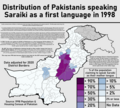ᱨᱮᱫ:Distribution of Pakistanis speaking Saraiki as a first language in 1998.png

ᱟᱥᱚᱞ ᱨᱮᱫ (᱒,᱗᱒᱐ x ᱒,᱔᱕᱐ pixels, file size: ᱗᱖᱑ KB, MIME type: image/png)
ᱱᱚᱣᱟ ᱨᱮᱫ ᱫᱚ ᱱᱚᱸᱰᱮ ᱠᱷᱚᱱ Wikimedia Commons ᱟᱨ ᱯᱟᱥᱮᱡ ᱮᱴᱟᱜ-ᱟ ᱯᱚᱨᱡᱮᱠᱴ ᱨᱮᱦᱚᱸ ᱵᱮᱵᱦᱟᱨᱚᱜ ᱠᱟᱱᱟ᱾ ᱱᱚᱣᱟ ᱨᱮᱭᱟ ᱯᱟᱥᱱᱟᱣ ᱠᱟᱛᱷᱟ ᱨᱮᱫ ᱯᱟᱥᱱᱟᱣ ᱥᱟᱦᱴᱟ ᱞᱟᱛᱟᱨᱨᱮ ᱮᱢ ᱮᱱᱟ᱾
ᱩᱱᱩᱫᱩᱜ
ᱢᱩᱬᱩᱛ ᱠᱟᱛᱷᱟ
| ᱵᱤᱵᱚᱨᱚᱱᱤDistribution of Pakistanis speaking Saraiki as a first language in 1998.png |
English: This map shows the percentage of people in each district of Pakistan who spoke Saraiki as their mother tongue at the time of the 1998 census.
The templates used to make this map can be found here. The source for the data used in the creation of this file can be found here (must be accessed through Google Earth or another application which opens .SHP files). All the data is adjusted for 2020 district borders. The image was created with Gimp and a calculator. --- What is Saraiki, and is it a language or a dialect?Saraiki, previously known as Multani, is a Northwestern Indo-Aryan tongue of the Lahnda group, and is spoken by about 26 - 28 million people mainly living in the Southwestern portion of Pakistan's Punjab province. It is mutually intelligible with both standard Punjabi and Sindhi, and shares a high degree of lexical similarity with both languages. While Saraiki is derived from Standard Punjabi and shares a large part of its vocabulary and morphology with Punjabi, its phonology is radically different (mainly in the lack of tones, the preservation of voiced aspirates, and the development of implosive consonants), closer to Sindhi, and it shares important grammatical features with Sindhi as well. The Saraiki identity arose in the 1960s, encompassing more narrow local identities (such as Multani, Thali, Derawal, and Riasti), and distinguishing itself from broader ones like Punjabi, and Saraiki was first listed as a separate language by the Census of Pakistan in 1981. Most Saraikis consider Saraiki a language in its own right, and see the use of the term dialect as stigmatizing, and many linguists agree due to its extremely high degree of leveling and its strong identity. It fits the ISO 639-3 standard for being a language and is thus listed as a language on Ethnologue, but many linguists still consider it a dialect mainly due to its relatively small literary tradition, its low level of prestige, its lack of official usage and recognition, and its low degree of differentiation, and it is listed as a Punjabi dialect on Glottolog. This remains a topic of controversy due to the lack of a universal standard for the difference between a dialect and a language. How many people speak Saraiki?In 1998, Saraiki was spoken by 10.53% of Pakistanis as a first language (13.94 million). 17% of the population of Punjab, 3.3% of the population of Khyber Pakhtunkhwa, 2.4% of the population of Balochistan, 1.1% of the population of Islamabad, and 1.0% of the population of Sindh spoke Saraiki as their mother tongue in 1998. By 2017, the share of Pakistanis claiming Saraiki as their mother tongue had risen to 12.19% (25.32 million). 21% of the population of Punjab, 3.2% of the population of Khyber Pakhtunkhwa, 2.7% of the population of Balochistan, 2.2% of the population of Sindh, and 2.1% of the population of Islamabad spoke Saraiki as their mother tongue in 2017. --- Jafarabad and Sohbatpur Districts in Balochistan (bordering Sindh) are marked "No Data" because it is impossible to determine their categories. The area which covers these two districts today was only one district in 1998, and the old tehsil borders of that district do not align with the current district borders. In 1998, though, 10.92% of the population of the two districts spoke Saraiki as their mother tongue. |
| ᱢᱟᱹᱦᱤᱛ | |
| ᱯᱷᱮᱰᱟᱛ | ᱤᱧᱟᱜ ᱠᱟᱹᱢᱤ |
| ᱚᱱᱚᱞᱤᱭᱟᱹ | Abbasi786786 |
ᱞᱟᱭᱥᱮᱱᱥ ᱛᱮᱭᱟᱨ
- ᱟᱲᱟᱜ ᱜᱮᱭᱟᱢ:
- ᱦᱟᱹᱴᱤᱧᱢᱮ – ᱱᱚᱠᱚᱞ ᱞᱟᱹᱜᱤᱫ, ᱦᱟᱹᱴᱤᱧ ᱟᱨ ᱵᱷᱮᱡᱟᱭᱢᱮ ᱠᱟᱹᱢᱤ
- ᱢᱮᱥᱟᱣᱠᱟᱛᱢᱮ – ᱠᱟᱹᱢᱤ ᱟᱞᱜᱟᱭ ᱞᱟᱹᱜᱤᱫ
- ᱞᱟᱛᱟᱨ ᱨᱮᱭᱟᱜ ᱨᱤᱛ ᱞᱮᱠᱟᱛᱮ:
- ᱟᱴᱨᱤᱵᱩᱥᱚᱱ – ᱟᱢ ᱠᱟᱹᱢᱤ ᱥᱚᱫᱚᱨ ᱦᱩᱭᱟᱢᱟ ᱡᱚᱠᱷᱚᱱ ᱚᱱᱚᱞᱤᱭᱟᱹ ᱟᱨᱵᱟᱝ ᱞᱟᱭᱥᱮᱸᱥᱩᱭᱟᱹ ᱫᱟᱨᱟᱭᱛᱮ ᱠᱟᱛᱷᱟ ᱨᱟᱠᱟᱵ ᱠᱷᱟᱱ (ᱢᱮᱱᱠᱷᱟᱱ ᱟᱠᱚ ᱩᱫᱩᱜᱟᱜ ᱦᱚᱨ ᱛᱮᱫᱚ ᱵᱟᱝ ᱡᱟᱦᱟᱸ ᱟᱠᱚᱠᱚ ᱜᱚᱲᱚᱣᱟᱢ ᱟᱨᱵᱟᱝ ᱟᱢᱟᱜ ᱠᱟᱹᱢᱤ ᱨᱮᱱᱟᱜ ᱵᱮᱵᱷᱟᱨ)
- ᱦᱟᱹᱴᱤᱧ ᱱᱚᱝᱠᱟ ᱜᱮ – ᱟᱢ ᱡᱩᱫᱤ ᱠᱟᱹᱢᱤ ᱵᱚᱫᱚᱞ, ᱛᱚᱨᱡᱚᱢᱟ, ᱵᱟᱝᱠᱷᱟᱱ ᱱᱚᱣᱟ ᱠᱟᱹᱢᱤ ᱪᱮᱛᱟᱱᱨᱮ ᱱᱟᱣᱟ ᱠᱟᱹᱢᱤ ᱥᱤᱨᱡᱟᱹᱣᱮᱢ ᱛᱮᱭᱟᱨ ᱠᱷᱟᱱ, ᱛᱚᱵᱮ ᱟᱢ ᱫᱚ ᱚᱱᱟ ᱠᱟᱹᱢᱤ ᱚᱱᱟ ᱢᱤᱫ ᱞᱟᱤᱥᱮᱱᱥ ᱥᱮ ᱚᱱᱟ ᱞᱮᱠᱟᱱᱟᱜ ᱞᱟᱤᱥᱮᱱᱥ ᱨᱮᱜᱮ ᱪᱟᱞ ᱦᱩᱭᱩᱜ ᱛᱟᱢᱟ᱾
Captions
creator ᱟᱝᱜᱽᱨᱮᱡᱤ
some value
copyright status ᱟᱝᱜᱽᱨᱮᱡᱤ
copyrighted ᱟᱝᱜᱽᱨᱮᱡᱤ
source of file ᱟᱝᱜᱽᱨᱮᱡᱤ
original creation by uploader ᱟᱝᱜᱽᱨᱮᱡᱤ
inception ᱟᱝᱜᱽᱨᱮᱡᱤ
᱑᱔ ᱰᱤᱥᱮᱢᱵᱚᱨ 2020
media type ᱟᱝᱜᱽᱨᱮᱡᱤ
image/png
ᱨᱮᱫ ᱨᱮᱭᱟᱜ ᱱᱟᱜᱟᱢ
ᱚᱠᱛᱚ ᱨᱮ ᱞᱤᱱ ᱢᱮ/ᱚᱠᱛᱚ ᱨᱮ ᱨᱮᱫ ᱧᱮᱞ ᱞᱟᱹᱜᱤᱛ ᱞᱤᱱ ᱢᱮ
| ᱢᱟᱹᱦᱤᱛ/ᱚᱠᱛᱚ | ᱴᱤᱯ | ᱡᱚᱠᱷᱟ | ᱵᱮᱵᱷᱟᱨᱤᱭᱟᱹ | ᱠᱟᱛᱷᱟ | |
|---|---|---|---|---|---|
| ᱱᱤᱛᱚᱜ | ᱒᱒:᱔᱑, ᱑᱔ ᱰᱤᱥᱮᱢᱵᱚᱨ ᱒᱐᱒᱐ |  | ᱒,᱗᱒᱐ × ᱒,᱔᱕᱐ (᱗᱖᱑ KB) | Abbasi786786 | Uploaded own work with UploadWizard |
ᱯᱷᱟᱭᱤᱞ ᱵᱮᱣᱦᱟᱨ
ᱞᱟᱛᱟᱨ ᱨᱮᱭᱟᱜ ᱥᱟᱦᱴᱟ ᱡᱚᱱᱚᱲᱠᱚ ᱱᱤᱭᱟᱹ ᱨᱮᱫ ᱨᱮ:
ᱡᱮᱜᱮᱛ ᱡᱟᱠᱟᱛ ᱨᱮᱫ ᱵᱮᱵᱷᱟᱨᱟᱜ
ᱱᱚᱶᱟ ᱨᱮᱫᱠᱚ ᱵᱮᱵᱷᱟᱨᱟᱠᱟᱫ ᱣᱤᱠᱤᱠᱚ :
- fr.wikipedia.org ᱨᱮ ᱵᱮᱣᱦᱟᱨ
- gl.wikipedia.org ᱨᱮ ᱵᱮᱣᱦᱟᱨ
- incubator.wikimedia.org ᱨᱮ ᱵᱮᱣᱦᱟᱨ
- pnb.wikipedia.org ᱨᱮ ᱵᱮᱣᱦᱟᱨ
- skr.wikipedia.org ᱨᱮ ᱵᱮᱣᱦᱟᱨ
- ur.wikipedia.org ᱨᱮ ᱵᱮᱣᱦᱟᱨ
ᱢᱮᱴᱟ ᱥᱟᱹᱠᱷᱭᱟᱹᱛ
ᱱᱚᱣᱟ ᱨᱮᱫ ᱨᱮᱫᱚ ᱵᱟᱹᱲᱛᱤ ᱠᱟᱛᱷᱟᱠᱚ ᱢᱮᱱᱟᱜ-ᱟ, ᱯᱟᱥᱮᱡ ᱱᱚᱣᱟ ᱫᱚ ᱰᱤᱡᱤᱴᱟᱞ ᱠᱮᱢᱨᱟ ᱥᱮ ᱮᱥᱠᱮᱱᱟᱨ ᱵᱮᱵᱦᱟᱨ ᱠᱟᱛᱮ ᱰᱤᱡᱤᱴᱟᱞ ᱟᱠᱟᱫᱟᱠᱚ᱾ ᱡᱩᱫᱤ ᱱᱚᱣᱟ ᱨᱮᱫ ᱨᱮᱭᱟᱜ ᱵᱩᱱᱤᱭᱟᱹᱫ ᱠᱷᱚᱱ ᱱᱟᱣᱟ ᱥᱩᱫᱷᱨᱟᱣ ᱞᱮᱱᱠᱷᱟᱱ, ᱯᱟᱥᱮᱡ ᱥᱟᱱᱟᱢᱠᱚ ᱛᱷᱚᱲᱟ ᱵᱟᱝᱠᱩ ᱥᱚᱫᱚᱨᱚᱜ-ᱟ ᱱᱚᱣᱟ ᱨᱮᱫ ᱨᱮᱫᱚ᱾
| PNG file comment |
|
|---|---|
| Horizontal resolution | ᱒᱘.᱓᱕ dpc |
| Vertical resolution | ᱒᱘.᱓᱕ dpc |
| File change date and time | ᱒᱓:᱑᱕, ᱒᱐ ᱚᱠᱴᱚᱵᱚᱨ ᱒᱐᱒᱐ |
